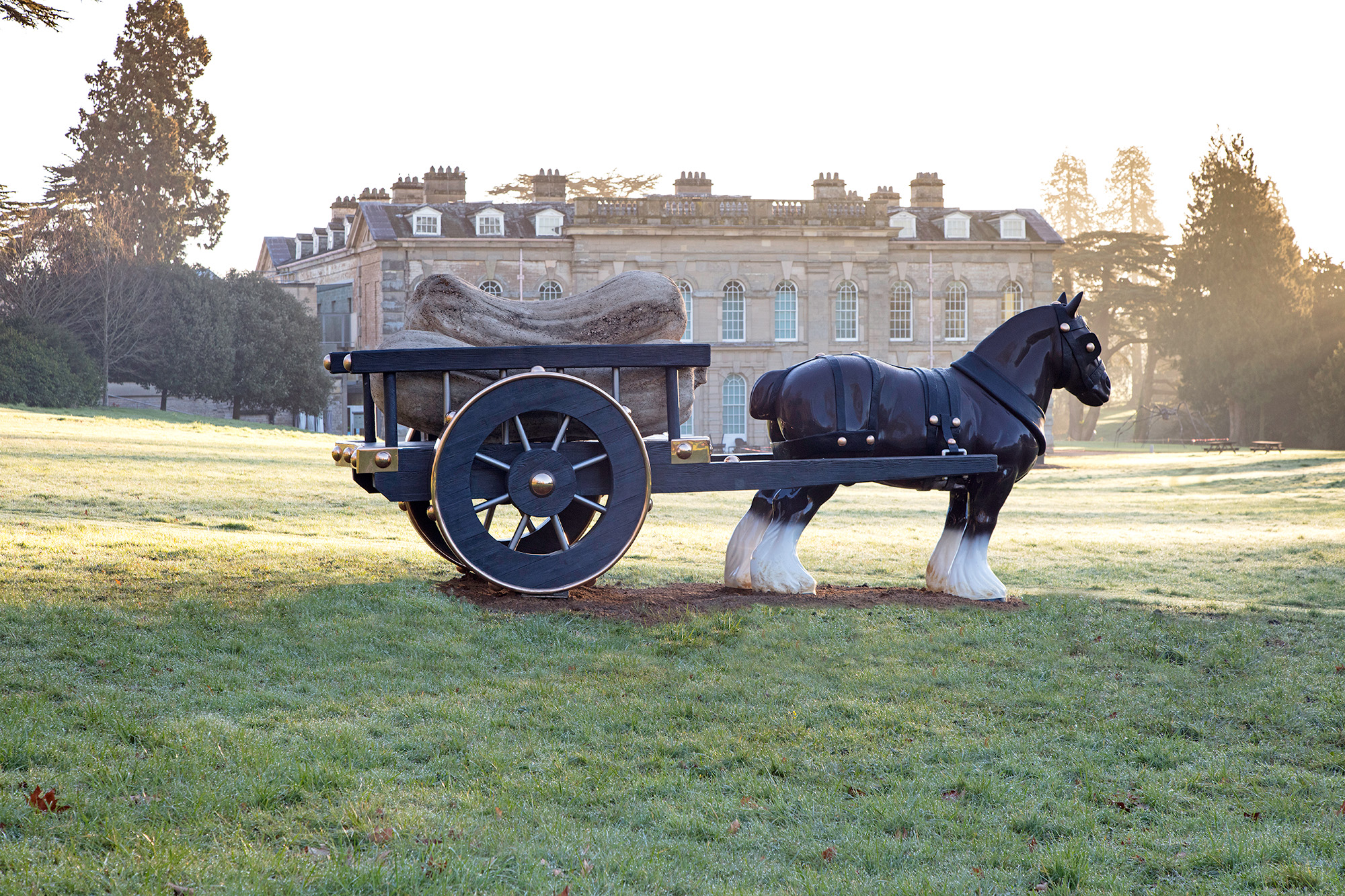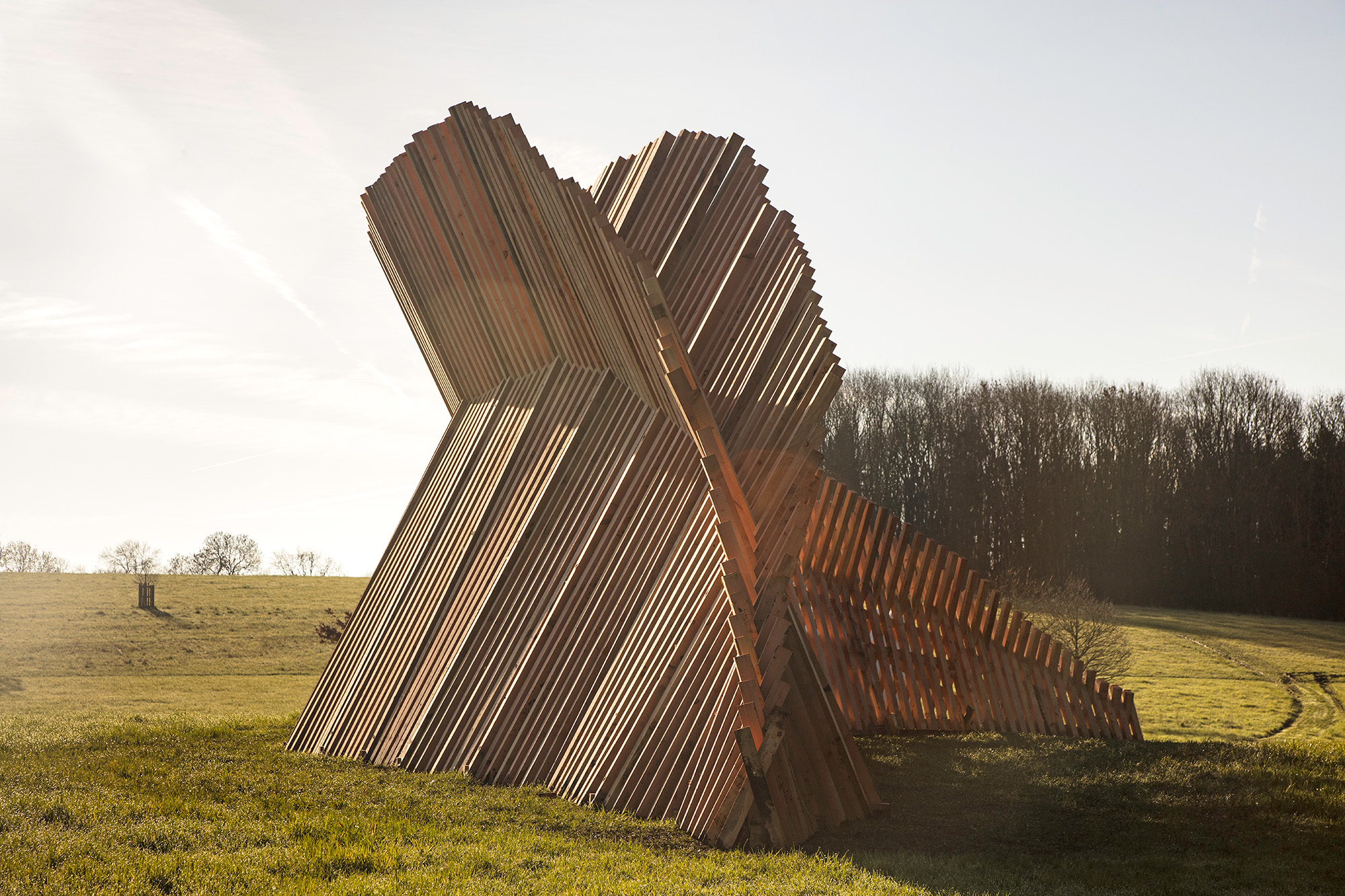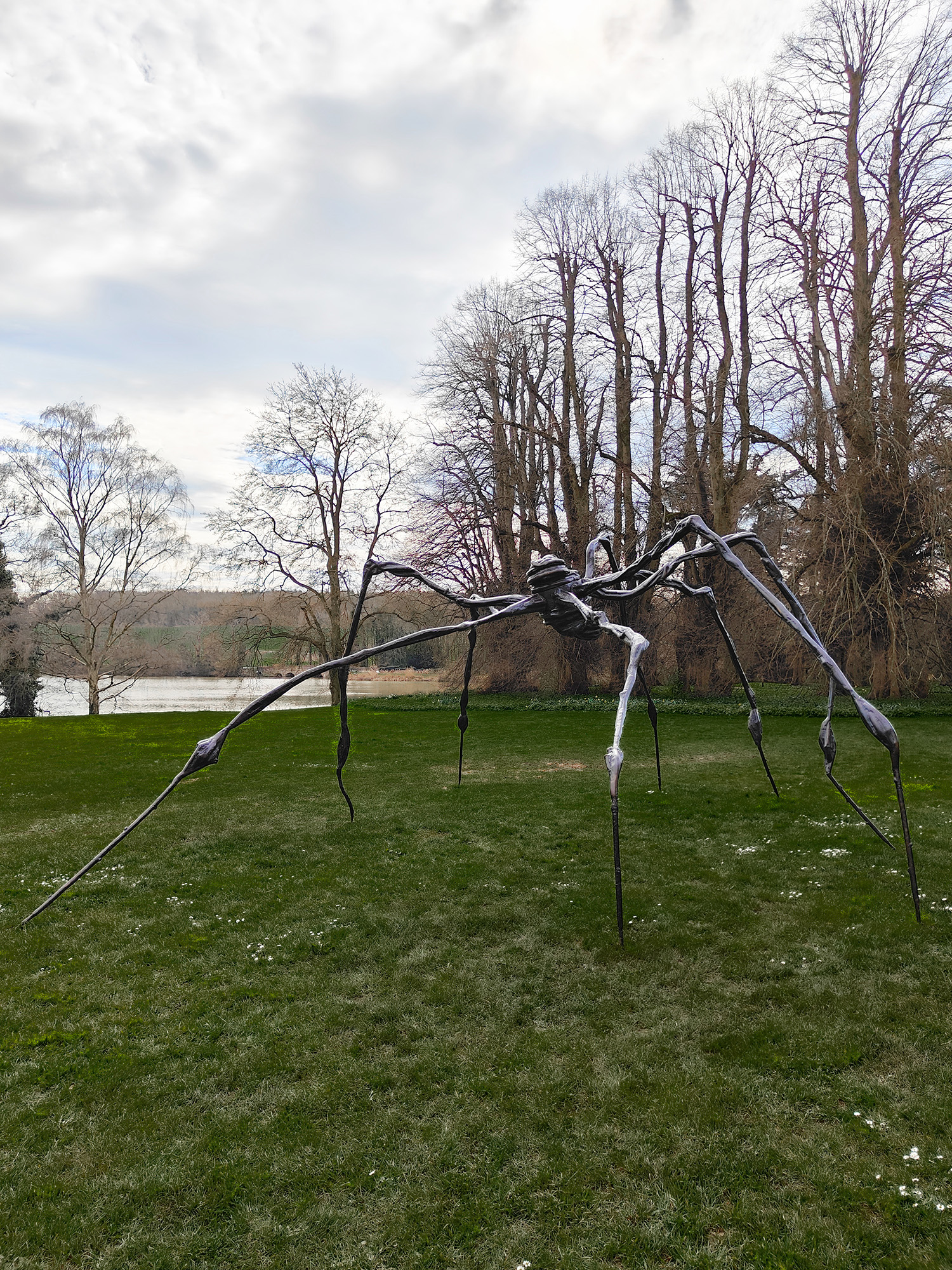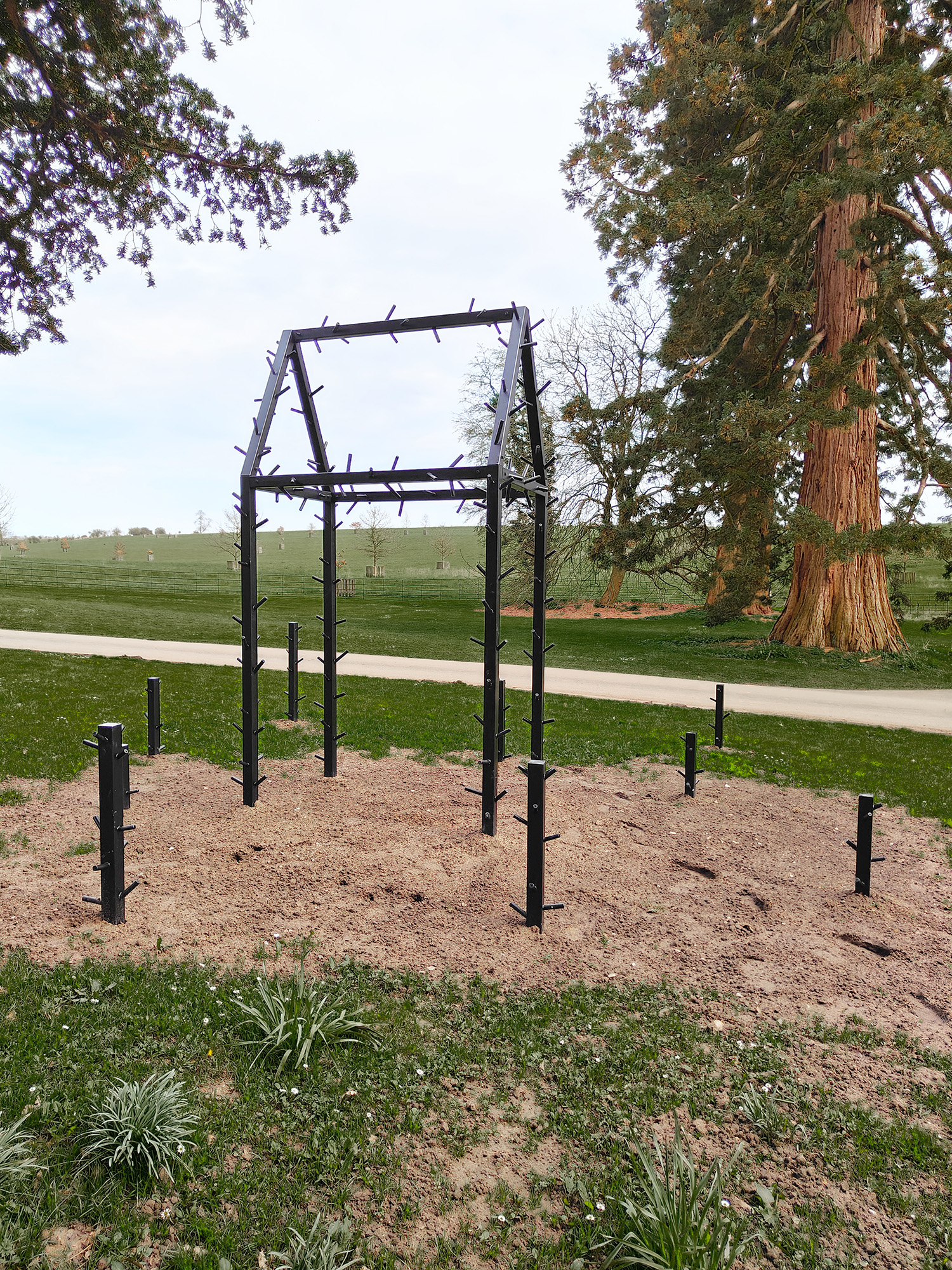Twisted & phallic sculptures have disrupted Capability
Brown’s smoothness at Compton Verney
A sculptural trail around the Capability Brown landscapes of
Compton Verney has opened, offering new perspectives onto the gardens and
Robert Adam-designed house. With works by Permindar Kaur, Augustas Serapinas,
Larry Achiampong, Erika Verzutti, Helen Chadwick, Louise Bourgeois, Nicolas
Deshayes & Sarah Lucas, Capability Brown’s smooth perfection is disrupted &
interrupted.
When Lancelot Capability Brown laid out the landscape
surrounding the grand neoclassical Compton Verney house, he also designed a
number of discrete buildings to be carefully located amongst the topology and
planting. Next to the main house, a 1760’s Robert Adam adaption and amendment
of a building that had already been altered and expanded over preceding
centuries, he designed a Chapel which mimics the main house’s roof lines and contains
an immaculately crisp, white interior.
Nearby, and in a plot within view of the rear of the main house, he placed a greenhouse which housed not only exotic and new plants, but also furniture and paintings. While along the serpentine entrance, close to one of two bridges he oversaw, is a thatched roof Ice House behind an insulated triangular entrance, set within the shade of yew trees and used for the storage of ice cream and sorbets.
Now, a number of other equally fascinating structures have appeared across the picturesque grasses. Eight diverse sculptural artworks have been carefully positioned around the landscape to test and provoke Brown’s framing and shaping of place, interventions that range from flags waving in the distance to weird fungal-like growth settled shallow into the lawn. As a collection, they are curated and placed to question the idea of utopia for today’s world, and form part of a range of exhibitions marking the 20th year of Compton Verney’s exhibiting and opening to the public.
![]()
![]()
figs.i,ii
Visitors entering the estate will immediately find themselves confronted by the largest of the sculptural works. Augustas Serapinas – an emerging Lithuanian artist we recently interviewed on recessed.space for his work in Lichtenfels, Austria (see 00153) – has constructed Standtune (2024), a leviathan-like mass of interlocking untreated Douglas Fir timbers, originally designed for the courtyard of the Gotland Museum in Sweden which was reimagined in Basel before now finding itself on the Old Town Meadow of the Compton Verney Estate.
The method of construction references ancient fencing techniques, sitting in place as if a fortress of sorts where once an historic settlement would also have had timber-construction defence. As a mass, it holds an empty void within, frustratingly unreachable to the visitor but somehow retained a precious emptiness, with the triangulated form also poetically playing against the Ice House structure facing across Brown’s entrance route.
![]()
![]()
figs.iii,iv
In proximity is Permindar Kaur’s steel Overgrown House (2020) a domestic-like form but with what looks like limbs and branches pollarded and cut short. It’s unnerving, a horror frame designed to imply regrowth but reminding of the necessity for death and destruction as part of that process. Nearby, Naked Venus (2024) sits observing a classical Browning postcard view across the lake and towards the main house, deliberately positioned to intervene in the public’s vantage of the same scene. Formed by artist Erika Verzutti of lacquered bronze, it forms part of a series of reimaginations of the 30,000 year old Venus of Willendorf, an 11cm tall large-breasted limestone figurine discovered in Austria and which here Verzutti transforms into a totem to reclaim the female gaze in a landscape wrought of masculine physicality, ego, and power.
Up in the distance, overlooking both these works and visible from the entire estate – and likely much further beyond – are five colourful flags designed by Larry Achiampong. Pan African Flag for the Relic Travellers’ Alliance (2021, 2021, 2018) are selected from an ongoing project using various graphic designs through a postcolonial perspective, considering a range issues needing to be addressed as we constantly stutter into the future. The flags chosen here celebrate community, self defence, and life.
Around the back of the main house Nicolas Deshayes’ Fountains (2018) are exactly as the title suggests, though these are no formal or classical jet of water, more a strange collection of Baroque-like intestinal aluminium forms, knotting into the air. There had previously been fountains in this location which had stopped working by the time Brown removed them to make way for his formal lawn.
Further away, seemingly watching other uncertainly, is Sarah Lucas’ horse Perceval (2006), an enlarged china ornament which is no stranger to grand country estates, an edition having previously also stood proudly in the grounds of Waddesdon Manor. In the cart behind the animal are two oversized marrows, a typical Lucas play on the phallic and fertile, here also reminding of the sheer brute force and physicality needed to manage, shape, and cultivate nature – even that which has the perfect polish of a porcelain ornament or smoothing of Capability Brown (see 00146).
![]()
![]()
![]()
The final two works, by Louise Bourgeois and Helen Chadwick, are found closer to the house, but around the side and interrupting smooth lawns that descend towards the lake. Bourgeois’ Spider (1996) has seemingly crawled to Warwickshire from its last location sat at the centre of one of the circular lawns of the Belvedere in Vienna. Here, it is less constrained by nature as it was in the formal Austrian gardens, but finds relaxed companionship to nature through proximity to the sinuous trunks and branches of the trees to one side, but when read against the manmade neoclassical and rigid façade of the house is altogether more threatening.
Chadwick’s Piss Flowers (1991-2) look like stunted mushrooms ruining Brown’s perfect grasses, awaiting the head gardener’s attentive removal. They are in fact formed of bronze, which would likely survive even the strongest chemical used by any modern-day groundsman, there form derived from a process of pissing into a flower-shaped mould set into Canadian snow, then cast into bronze. The act of pissing ruptured and broke the ground’s surface, so when the bronze was set it formed into a subterranean stalactite, which here becomes a phallic stalagmite now turned upside down. What Capability Brown would have made of such a poke into his design nearly 250 years after he laid it out, one can only imagine.
![]()
![]()
Though these eight works don’t penetrate deeply into the vast Compton Verney landscapes, staying quite tight to the house and entrance road – other than Achiampong’s fluttering flags which are best kept at distance unless the visitor wishes to slip and slide through mud as they struggle to reach the peak they are erected upon – they push against the formal, picturesque mannerism of the place quite playfully. Having just been put into place, there are still visible disruptions with the lawn and gardens beneath and around, but now in place for two years they find the landscape grows up to and under them seamlessly, and perhaps in time lose their shock value as they assimilate into the place.
The works decorate the estate, and while offer intriguing staging posts on a short walk around the site also ask questions about how to read such controlled, masculine, and dominant spaces that Capability Brown and Robert Adam designed. In the 18th century, utopia for the wealthy, landed Peyto-Verney family was one formed by the best men available, shaping an idealised and improved version of nature and classical architecture. These works provoke questions about what a different utopia may look like.
Now that Compton Verney is open to the public – albeit with an entrance fee and at the invitation of the current owners – the once deeply-private place has become a little more democratic. These works perhaps ask what the next steps of such democratic social shift might be, whether that means subverting a patriarchal control of place, an invitation for animals to grow and inhabit, or a return to the past to find future forms.
Nearby, and in a plot within view of the rear of the main house, he placed a greenhouse which housed not only exotic and new plants, but also furniture and paintings. While along the serpentine entrance, close to one of two bridges he oversaw, is a thatched roof Ice House behind an insulated triangular entrance, set within the shade of yew trees and used for the storage of ice cream and sorbets.
Now, a number of other equally fascinating structures have appeared across the picturesque grasses. Eight diverse sculptural artworks have been carefully positioned around the landscape to test and provoke Brown’s framing and shaping of place, interventions that range from flags waving in the distance to weird fungal-like growth settled shallow into the lawn. As a collection, they are curated and placed to question the idea of utopia for today’s world, and form part of a range of exhibitions marking the 20th year of Compton Verney’s exhibiting and opening to the public.


figs.i,ii
Visitors entering the estate will immediately find themselves confronted by the largest of the sculptural works. Augustas Serapinas – an emerging Lithuanian artist we recently interviewed on recessed.space for his work in Lichtenfels, Austria (see 00153) – has constructed Standtune (2024), a leviathan-like mass of interlocking untreated Douglas Fir timbers, originally designed for the courtyard of the Gotland Museum in Sweden which was reimagined in Basel before now finding itself on the Old Town Meadow of the Compton Verney Estate.
The method of construction references ancient fencing techniques, sitting in place as if a fortress of sorts where once an historic settlement would also have had timber-construction defence. As a mass, it holds an empty void within, frustratingly unreachable to the visitor but somehow retained a precious emptiness, with the triangulated form also poetically playing against the Ice House structure facing across Brown’s entrance route.


figs.iii,iv
In proximity is Permindar Kaur’s steel Overgrown House (2020) a domestic-like form but with what looks like limbs and branches pollarded and cut short. It’s unnerving, a horror frame designed to imply regrowth but reminding of the necessity for death and destruction as part of that process. Nearby, Naked Venus (2024) sits observing a classical Browning postcard view across the lake and towards the main house, deliberately positioned to intervene in the public’s vantage of the same scene. Formed by artist Erika Verzutti of lacquered bronze, it forms part of a series of reimaginations of the 30,000 year old Venus of Willendorf, an 11cm tall large-breasted limestone figurine discovered in Austria and which here Verzutti transforms into a totem to reclaim the female gaze in a landscape wrought of masculine physicality, ego, and power.
Up in the distance, overlooking both these works and visible from the entire estate – and likely much further beyond – are five colourful flags designed by Larry Achiampong. Pan African Flag for the Relic Travellers’ Alliance (2021, 2021, 2018) are selected from an ongoing project using various graphic designs through a postcolonial perspective, considering a range issues needing to be addressed as we constantly stutter into the future. The flags chosen here celebrate community, self defence, and life.
Around the back of the main house Nicolas Deshayes’ Fountains (2018) are exactly as the title suggests, though these are no formal or classical jet of water, more a strange collection of Baroque-like intestinal aluminium forms, knotting into the air. There had previously been fountains in this location which had stopped working by the time Brown removed them to make way for his formal lawn.
Further away, seemingly watching other uncertainly, is Sarah Lucas’ horse Perceval (2006), an enlarged china ornament which is no stranger to grand country estates, an edition having previously also stood proudly in the grounds of Waddesdon Manor. In the cart behind the animal are two oversized marrows, a typical Lucas play on the phallic and fertile, here also reminding of the sheer brute force and physicality needed to manage, shape, and cultivate nature – even that which has the perfect polish of a porcelain ornament or smoothing of Capability Brown (see 00146).



figs.v-vii
The final two works, by Louise Bourgeois and Helen Chadwick, are found closer to the house, but around the side and interrupting smooth lawns that descend towards the lake. Bourgeois’ Spider (1996) has seemingly crawled to Warwickshire from its last location sat at the centre of one of the circular lawns of the Belvedere in Vienna. Here, it is less constrained by nature as it was in the formal Austrian gardens, but finds relaxed companionship to nature through proximity to the sinuous trunks and branches of the trees to one side, but when read against the manmade neoclassical and rigid façade of the house is altogether more threatening.
Chadwick’s Piss Flowers (1991-2) look like stunted mushrooms ruining Brown’s perfect grasses, awaiting the head gardener’s attentive removal. They are in fact formed of bronze, which would likely survive even the strongest chemical used by any modern-day groundsman, there form derived from a process of pissing into a flower-shaped mould set into Canadian snow, then cast into bronze. The act of pissing ruptured and broke the ground’s surface, so when the bronze was set it formed into a subterranean stalactite, which here becomes a phallic stalagmite now turned upside down. What Capability Brown would have made of such a poke into his design nearly 250 years after he laid it out, one can only imagine.


figs.viii,ix
Though these eight works don’t penetrate deeply into the vast Compton Verney landscapes, staying quite tight to the house and entrance road – other than Achiampong’s fluttering flags which are best kept at distance unless the visitor wishes to slip and slide through mud as they struggle to reach the peak they are erected upon – they push against the formal, picturesque mannerism of the place quite playfully. Having just been put into place, there are still visible disruptions with the lawn and gardens beneath and around, but now in place for two years they find the landscape grows up to and under them seamlessly, and perhaps in time lose their shock value as they assimilate into the place.
The works decorate the estate, and while offer intriguing staging posts on a short walk around the site also ask questions about how to read such controlled, masculine, and dominant spaces that Capability Brown and Robert Adam designed. In the 18th century, utopia for the wealthy, landed Peyto-Verney family was one formed by the best men available, shaping an idealised and improved version of nature and classical architecture. These works provoke questions about what a different utopia may look like.
Now that Compton Verney is open to the public – albeit with an entrance fee and at the invitation of the current owners – the once deeply-private place has become a little more democratic. These works perhaps ask what the next steps of such democratic social shift might be, whether that means subverting a patriarchal control of place, an invitation for animals to grow and inhabit, or a return to the past to find future forms.


